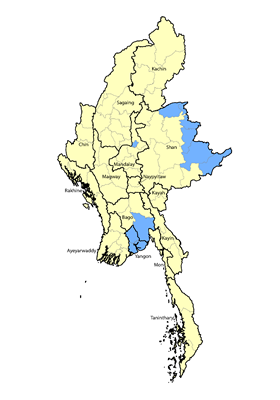Han Chinese, Mandarin in Myanmar (Burma)

Photo Source:
Jakob Montrasio - Wikimedia
Creative Commons
|

Map Source:
Asia Harvest-Operation Myanmar
|
| People Name: | Han Chinese, Mandarin |
| Country: | Myanmar (Burma) |
| 10/40 Window: | Yes |
| Population: | 1,051,000 |
| World Population: | 925,156,200 |
| Primary Language: | Chinese, Mandarin |
| Primary Religion: | Buddhism |
| Christian Adherents: | 4.00 % |
| Evangelicals: | 1.40 % |
| Scripture: | Complete Bible |
| Ministry Resources: | Yes |
| Jesus Film: | Yes |
| Audio Recordings: | Yes |
| People Cluster: | Chinese |
| Affinity Bloc: | East Asian Peoples |
| Progress Level: |
|
Identity
The Chinese in Myanmar are divided into those whose forefathers migrated generations ago, and more recent arrivals who came as a result of China’s new economic boom. The Burmese call Chinese people “Tayoke,” although since the 1950s, paukphaw (‘sibling’) has been co-opted as an affectionate term for the Chinese and is now typically used in the context of diplomatic ties between China and Myanmar. The term itself purportedly originates from a Burmese myth about the Chinese and Burmese peoples being descended from the same parents, a dragon princess and a sun god.”
Location: The Han Chinese are the largest ethnic group on earth, and Mandarin is the world’s most widely spoken language. Mandarin speakers are found scattered throughout the world, with communities probably in every country. Fueled by decades of China’s one-child policy, however, the demographic makeup of the Han Chinese ethnicity is extremely grim, and their population is set to dramatically plummet in the coming years and decades. More than one million Mandarin-speaking Chinese live in Myanmar. They are scattered throughout the country, with many living in northern border areas within Shan and Kachin states, while others reside in major cities including Yangon, Mandalay, and Bago.
Language: More than 960 million Chinese people worldwide speak Mandarin (known as Putonghua, “the common speech”) as their mother tongue. Mandarin-speaking Chinese are found all over China, and the Beijing dialect is the standard used in media and education. There is remarkable linguistic uniformity among Mandarin speakers. Chinese from diverse locations can understand one another without too much difficulty.
History
The first recorded migrations of Han people into Myanmar occurred during the Song Dynasty (AD 960 - 1279). In the 19th century the British encouraged Chinese to immigrate to Burma, and many wealthy merchants set up businesses that dominated the rice and precious stones industries. Men would often come with the intention of making a fortune before returning to their wives in China, but they took Burmese second wives or mistresses. Consequently, a mixed race, profiled in this book as the “Sino-Burmese,” emerged. The 21st century has seen an influx of new Chinese into Myanmar as China seeks to expand their regional influence.
Customs
By the 1950s the Chinese had gained a prominent role in society and ran many of Myanmar’s businesses and banks, which created tension with the Burmese. When General Ne Win seized power in 1962, he banned Chinese schools and stirred up ethnic hatred. Many riots ensued and Chinese businesses were burned to the ground, resulting in over 100,000 Chinese fleeing the country.4 Their numbers recovered over time, however, and by 1983, Mandarin-speaking Chinese in Myanmar totaled 233,470 - more than double the 109,566 recorded in the 1931 census.
Religion
The Chinese have been most influenced by Mahayana Buddhism, Daoism, and Confucianism throughout their history, but since the advent of Communism in 1949, most Mandarin-speaking Chinese inside China have been educated in atheistic schools and are nonreligious. Christianity struggled to gain a foothold among the Chinese in Myanmar during the colonial era, with only fleeting mentions of work among them in missionary records. One book lamented: “In 1878, six Chinamen were baptized and Chinese Bibles and prayer books were obtained for them, but the work dwindled through the persecution of the heathen Chinese societies, and because no Chinese clergyman was forthcoming for their supervision…. The converts were terrorized by the secret societies or clubs to which all the Chinese belong.”
Christianity
Although Christians have been present in China since at least AD 635 when 21 Nestorian monks from Persia commenced work, the church in China waxed and waned for centuries. Since the 1980s, China has experienced one of the greatest revivals in Christian history, with some regions experiencing strong growth for 30 years. In the last few decades, hundreds of thousands of Mandarin-speaking Chinese have flooded into Myanmar. Many have come on work contracts, while others came to conduct missionary work in northern Myanmar, primarily among other Chinese people. Today it is conservatively estimated that about 42,000 (4%) of Mandarin-speaking Chinese people in Myanmar are followers of Christ.